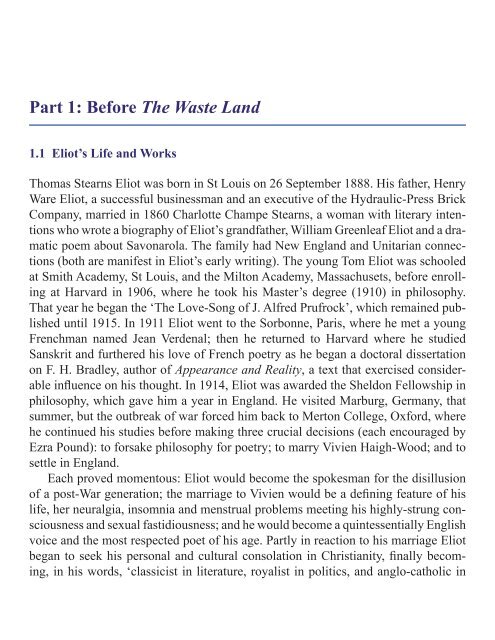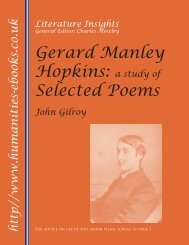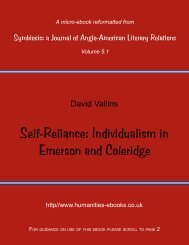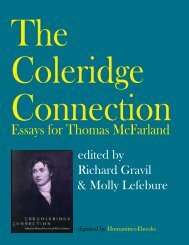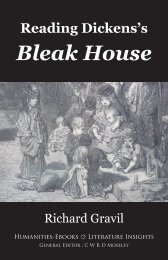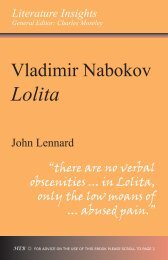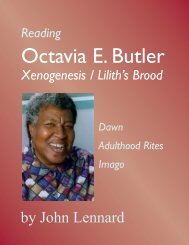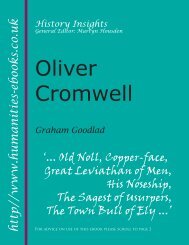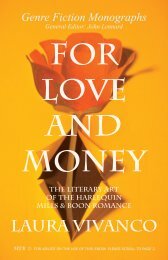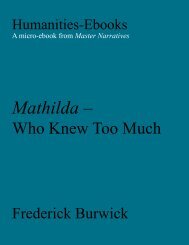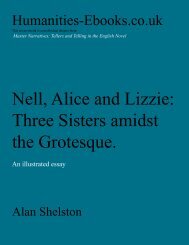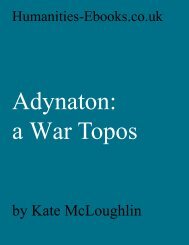T S Eliot: The Love Song of J Alfred Prufrock and The Waste Land
T S Eliot: The Love Song of J Alfred Prufrock and The Waste Land
T S Eliot: The Love Song of J Alfred Prufrock and The Waste Land
Create successful ePaper yourself
Turn your PDF publications into a flip-book with our unique Google optimized e-Paper software.
Part 1: Before <strong>The</strong> <strong>Waste</strong> L<strong>and</strong><br />
1.1 <strong>Eliot</strong>’s Life <strong>and</strong> Works<br />
Thomas Stearns <strong>Eliot</strong> was born in St Louis on 26 September 1888. His father, Henry<br />
Ware <strong>Eliot</strong>, a successful businessman <strong>and</strong> an executive <strong>of</strong> the Hydraulic-Press Brick<br />
Company, married in 1860 Charlotte Champe Stearns, a woman with literary intentions<br />
who wrote a biography <strong>of</strong> <strong>Eliot</strong>’s gr<strong>and</strong>father, William Greenleaf <strong>Eliot</strong> <strong>and</strong> a dramatic<br />
poem about Savonarola. <strong>The</strong> family had New Engl<strong>and</strong> <strong>and</strong> Unitarian connections<br />
(both are manifest in <strong>Eliot</strong>’s early writing). <strong>The</strong> young Tom <strong>Eliot</strong> was schooled<br />
at Smith Academy, St Louis, <strong>and</strong> the Milton Academy, Massachusets, before enrolling<br />
at Harvard in 1906, where he took his Master’s degree (1910) in philosophy.<br />
That year he began the ‘<strong>The</strong> <strong>Love</strong>-<strong>Song</strong> <strong>of</strong> J. <strong>Alfred</strong> <strong>Prufrock</strong>’, which remained published<br />
until 1915. In 1911 <strong>Eliot</strong> went to the Sorbonne, Paris, where he met a young<br />
Frenchman named Jean Verdenal; then he returned to Harvard where he studied<br />
Sanskrit <strong>and</strong> furthered his love <strong>of</strong> French poetry as he began a doctoral dissertation<br />
on F. H. Bradley, author <strong>of</strong> Appearance <strong>and</strong> Reality, a text that exercised considerable<br />
influence on his thought. In 1914, <strong>Eliot</strong> was awarded the Sheldon Fellowship in<br />
philosophy, which gave him a year in Engl<strong>and</strong>. He visited Marburg, Germany, that<br />
summer, but the outbreak <strong>of</strong> war forced him back to Merton College, Oxford, where<br />
he continued his studies before making three crucial decisions (each encouraged by<br />
Ezra Pound): to forsake philosophy for poetry; to marry Vivien Haigh-Wood; <strong>and</strong> to<br />
settle in Engl<strong>and</strong>.<br />
Each proved momentous: <strong>Eliot</strong> would become the spokesman for the disillusion<br />
<strong>of</strong> a post-War generation; the marriage to Vivien would be a defining feature <strong>of</strong> his<br />
life, her neuralgia, insomnia <strong>and</strong> menstrual problems meeting his highly-strung consciousness<br />
<strong>and</strong> sexual fastidiousness; <strong>and</strong> he would become a quintessentially English<br />
voice <strong>and</strong> the most respected poet <strong>of</strong> his age. Partly in reaction to his marriage <strong>Eliot</strong><br />
began to seek his personal <strong>and</strong> cultural consolation in Christianity, finally becoming,<br />
in his words, ‘classicist in literature, royalist in politics, <strong>and</strong> anglo-catholic in


